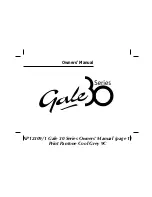
be beneficial in situations where excessive noise is ex-
perienced due to high flow rates into the drainback
tank.
A brass boiler drain (COMPONENT #11) must be in-
stalled at the lowest point in the system to allow for
charging the solar loop piping and to serve as a drain
valve for manual draining and maintenance.
A high quality thermostatic mixing valve is a required
component in all OG-300 certified systems and should
be plumbed in line with brass union connections for
ease of future repair or replacement. The mixing valve
shall be standard ASSE 1017 approved. The specified
mixing valve should have an operating range between
95°F and 120°F. The mixing valve shall include a set
point of 120°F delivered water temperature.
WARNING: SCALDING CAN OCCUR WITHIN FIVE SEC-
ONDS WHEN WATER TEMPERATURES APPROACH 140°
F. DESPITE THE INSTALLATION OF A MIXING VALVE
IN YOUR TORRENT DRAINBACK SYSTEM, ALWAYS EX-
ERCISE CAUTION WHEN OPENING A HOT WATER FIX-
TURE OR FAUCET IN YOUR HOME.
The 3/4” cold water supply line to the solar storage
tank shall be insulated with R-2.6 or greater pipe insu-
lation to a minimum distance of 5’ behind the storage
tank, or to the wall if closer than 5’.
Figures 11, 12 and 13 show the plumbing schematics
for single and two tank Torrent Drainback systems. A
brief explanation of the main components and their
function is found in Section 10 below.
4.8 Tank Sensor Placement
Figure 13 details the proper placement of the solar
storage tank sensor. The tank sensor shall have good
thermal contact with the tank wall in order to accurate-
ly measure the temperature of the water at the bottom
of the tank. It is recommended that the sensor be in-
stalled in a brass or copper thermal well screwed into
the lower sensor port in the tank.
Thoroughly weatherize the wire connections in accord-
ance with section 4.6.2.
4.9 Tank Insulation
Conventional back-up electric water heaters have insu-
lation values between R-12 and R-20. the R value ex-
presses the thermal resistance of the tank insulation.
The higher the “R-value” the more effective the insula-
tion is at preventing heat loss. The use of any solar
storage tank with an R value belowR-12 is prohibited.
The storage tank should not be placed directly on an
un-insulated floor or concrete slab, in order to prevent
moisture damage to the base of the tank and reduce
the heat loss to the floor. The tank should be raised off
the floor on a pad.
4.10 Choosing and Installing the Drainback Res-
ervoir
SunEarth CopperStorTM copper drainback tanks are
available in 2.5; 5; 7.5 and 10 gallon capacities. Stain-
less steel drainback tanks are available in 10; 15 and
20 gallons. Small glass lined steel electric water heat-
ers available in various sizes from 6 to 20 gallons can
also be used as drainback tanks; do not connect the
heating element when using these tanks as a drainback
reservoir. The minimum drainback tank volume must
be DOUBLE the volume of the piping and collector loop
above the initial fill level of the system. This volume is
calculated from the fluid capacity of all the collectors in
the system plus all piping above the drainback tank fill
level.
Select the appropriate tank based on the collector(s)
chosen and the total length of solar supply and return
loop piping in the system. Table 1 and Table 2 indi-
cate the proper drainback tank for the two most com-
mon piping scenarios. Our preference is to use Table 1:
1/2” piping for the supply line and 3/4” piping for the
return line. This provides some flow related benefits,
extends the allowable pipe run and is slightly less ex-
pensive.
The drainback reservoir shall be mounted in a location
that is NEVER subjected to freezing conditions. The
drainback tank may be mounted to a wall using brack-
ets or on a stand over the solar tank. The outlet of the
drainback tank should be at least 48” above the suction
side of the circulating pump to give sufficient net posi-
tive suction head available to the pump (See Figures
11, 12 and 13).
The drainback reservoir should be installed at the high-
est location practicable. The benefits of this include:
reduced risk of pump cavitation; reduced pumping
head required to fill the system allowing smaller pumps
to be used; and reduced piping above the drainback
reservoir allowing smaller drainback tanks. In build-
ings with two or more floors, it is beneficial to install
TABLE 1
ARRAY
DB-5
DB-7.5
DB-10
1 EP/EC-40
82
138
194
2 EP/EC-21
76
132
188
2 EP/EC-24
73
129
185
2-EP/EC-32
62
118
174
PIPE RUN LENGTHS FOR 1/2” TYPE M AND 3/4” TYPE M
RETURN LINES.
TABLE 2
ARRAY
DB-5
DB-7.5
DB-10
1 EP/EC-40
61
103
144
2 EP/EC-21
57
98
140
2 EP/EC-24
54
96
138
2-EP/EC-32
46
88
130
PIPE RUN LENGTHS FOR 3/4” TYPE M AND 3/4” TYPE M
RETURN LINES.
Summary of Contents for CASCADE 2
Page 29: ...APPENDIX F ...
Page 30: ...APPENDIX F ...
















































